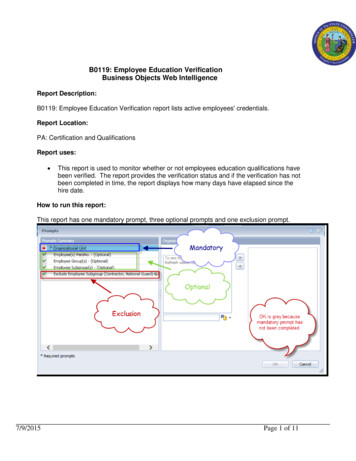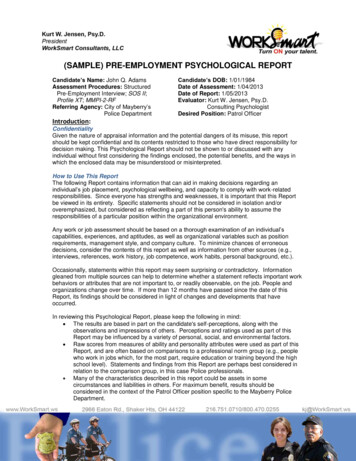
Transcription
a report on How A/E/C Firms AreUsing Staff to Win More Work.
SMPS PUBLICATIONS is an imprint of theSociety for Marketing Professional Services (SMPS)123 N. Pitt Street, Suite 400, Alexandria, VA 22314800.292.7677 703.549.6117 www.smps.org 2016 by SMPS and the SMPS FoundationResearch data and graphs compiled byMcKinley AdvisorsSMPS is a registered service mark of theSociety for Marketing Professional ServicesAuthor: Scott D. Butcher, FSMPS, CPSMAll rights reserved. No part of this research report maybe reprinted or reproduced or utilized in any form orby any electronic, mechanical or other means, nowknown or hereafter invented, including photocopyingand recording, or in any information storage or retrievalsystem, without permission in writing from the Societyfor Marketing Professional Services (SMPS).
Sell. Do. Win Business.The business development modelwithin A/E/C firms continues to evolve,engaging more staff as firms seek totransform their cultures. This researchfound that companies have robustroles for both dedicated businessdevelopers as well as technicalprofessionals in seller-doer roles, eventhough the ‘traditional’ responsibilitiesmay be changing.—Scott D. Butcher, FSMPS, CPSM
Research and datacompiled byTABLE OFCONTENTS01The Changing Marketplace02How Are A/E/C Firms Handling Business Development?04Business Developers07Seller-Doers12Roles and Responsibilities18Goals, Incentives, and Training23The Future of Business Development26Project Leadership27Additional Resources
01Sell. Do. Win Business.The Changing MarketplaceINTRODUCTION BY:PAULA M. RYAN, FSMPS, CPSMSMPS PRESIDENTDIRECTOR OF MARKETING FORJEZERINAC GEERS & ASSOCIATES, INC.ANDHOLLY R. BOLTON, FSMPS, CPSMSMPS FOUNDATION PRESIDENTDIRECTOR OF MARKETING FORCE SOLUTIONS, INC.The SMPS Foundation is partnering with the Society forMarketing Professional Services (SMPS) to discover whatmakes architecture, engineering, and construction (A/E/C)organizations successful in marketing and businessdevelopment. Our goal has always been to provide SMPSmembers and their firms a way to build business throughnetworking, business intelligence, and industry research.In line with this goal, the SMPS Foundation—alongsideSMPS—has made it a priority to research the latest industryand professional-related topics and trends. We’re exploring acontinually relevant and often-discussed theme in the A/E/Cspace: how firms approach business development. Realizingthat everyone contributes to bringing in work in different ways,when it comes to specific business development activities, whotakes on those responsibilities and what they include can vary.This report provides a snapshot of key findings and lay-of theland statistics of how firms approach, structure, and supportbusiness development efforts. Other publications by SMPS andthe SMPS Foundation will present additional research outcomesfrom this project and provide takeaways you can apply to helpbuild business for your firm.highlights92%Percentage of firms with 500 ormore employees reported havingbusiness developers on staff.57%Percentage who indicated thatmore than 75 percent of theirfirms’ technical staff have BDresponsibilities.81%Percentage of firms with 1-4employees that reported nofull-time business developers.
02Sell. Do. Win Business.How Are A/E/C Firms Handling Business Development?BusinessDevelopmentAuthor:Scott D. Butcher,FSMPS, CPSMIn many ways, business development isthe lifeline of any professional servicesorganization. You can’t do what you don’tsell. But “sell” is often treated as a fourletter word in architectural, engineering, andconstruction (A/E/C) firms—a necessary evilthat gobbles up billable hours and createstoo much overhead. In fact, sales oftenisn’t even called sales; the industry prefersbusiness development, which is apparentlymuch more palatable.But how are firms handling businessdevelopment? Who is responsible for it?What are they doing with their time? Are theyproperly trained? These are the questionsthat the Society for Marketing ProfessionalServices (SMPS) and the SMPS Foundationset out to answer.The genesis of the project was a 2013research effort of the SMPS Foundationthat resulted in the book A/E/C BusinessDevelopment—The Decade Ahead.In that research initiative, the SMPSFoundation interviewed 100 sellers andbuyers of design and construction servicesto get a handle on current trends andfuture directions of sales—that is, businessdevelopment—in the A/E/C industry. Thesellers (design and construction firms) notedthat they were integrating technical peopleinto the selling process earlier and earlier.The buyers (clients and owners) in certainmarket sectors noted a strong preferencefor meeting with the people who would beinvolved with their project(s)—not someonewho just opened the door and came back amonth later with project team members.About scottVice Presidentand CMO of JDBEngineeringSMPS Foundation2015-16 Treasurer
03Sell. Do. Win Business.Are A/E/C firms doing away with their dedicated salesprofessionals and replacing them with technical staffmembers who split their duties between sales andbillable work? Is the business development modelchanging? Or is it all much ado about nothing: firmstalking the talk, but not walking the walk?Project ObjectiveThe project objective was to better understand currentbusiness development practices within A/E/C firmsand explore the anticipated changes in roles andresponsibilities for new business development in thefuture.To answer these questions and gain better insight intobusiness development trends and forthcoming changes,SMPS and the SMPS Foundation teamed up to take adeeper look into the status of business development inthe A/E/C industry.Project OverviewPlanning for the Business Development Survey beganin March 2015, with an electronic survey distributedto members of the Society for Marketing ProfessionalServices (SMPS), American Institute of Architects (AIA),Associated General Contractors of America (AGC), andNational Council of Structural Engineering Associations(NCSEA) late spring through early summer 2015. An opensurvey, promoted through social media, was also postedonline. Upon completion of the quantitative portion of thestudy, an initial analysis was performed in July 2015. InAugust, the qualitative survey rolled out with a series oftelephone interviews performed over a two-month period.Final analysis was completed in autumn 2015.Using a research template originally developed by SMPSFoundation Trustees William R. Long, PE, LEED AP,FSMPS, CPSM, and Scott D. Butcher, FSMPS, CPSM, fortheir personal research, the organizations commissionedMcKinley Advisors to conduct a nationwide survey ofdesign and construction firms, reaching out to severalpartner organizations to engage their members in theresearch.In total, 1,372 electronic surveyresponses were received, with abouttwo-thirds of respondents beingmembers of SMPS and one-thirdbeing members of either AIA, AGC, orNCSEA. An additional 41 qualitativeinterviews were completed, with 21participants describing themselvesas seller-doers and 19 describingthemselves as dedicated businessdevelopers.
04Sell. Do. Win Business.business developersBUSINESS DEVELOPERS are dedicatedemployees who secure contracts orprojects for their respective firms, eitherthrough repeat clients or fosteringrelationships with new clients.KEY FINDINGLarger firms and constructionfirms are more likely toemploy business developers.
05Sell. Do. Win Business.BusinessDevelopersBusiness Developers are dedicatedemployees who secure contracts or projectsfor their respective firms, either throughrepeat clients or fostering relationships withnew clients. Their knowledge of the industryis primarily based on their experience andnot necessarily from technical education.As expected among all types, firms withfewer than five employees were unlikelyto have dedicated business developers;however, 19 percent of firms in this sizerange reported that they have engagedin business development. Conversely, 92percent of firms with 500 or more employeesreported having business developers ontheir payroll. A/E/C firms with fewer than500 employees are most likely to have1-4 dedicated business developers on staff,while firms with 500 or more employees aremost likely to have 15 or more dedicatedbusiness developers.Interestingly, the 100-499 employeecategory still reveals that 13 percent of firmshave no business developers, 58 percenthave 1-4 business developers, and 25percent have 5-14 business developers, so itreally isn’t until the 500 employee size thatthere is a significant jump in the number ofbusiness developers that a firm employs onstaff.Architectural firms are most likely to have nobusiness developers, with a full 40 percentof participants reporting that they do notemploy dedicated business developers.Contractors are the most likely to havethis position on staff, with only 13 percentreporting that they don’t employ businessdevelopers. For engineering firms, 18percent reported that they do not employbusiness developers.Full-Time Business Developers by Firm Size500 employees or more100-499 employees8%92%13%87%26%25-99 employees74%52%48%10-24 employees58%5-9 employees1-4 employees42%81%19%No Business DevelopersHas Business Developers
06Sell. Do. Win Business.KEY FINDINGLarge engineering firms and construction firms are more likely to report that thenumber of business developers employed at their firm has increased over thepast 10 years.When asked about the change innumber of business developersover the past decade, the majorityof firms with fewer than 25employees reported that therewas no change in the number ofbusiness developers comparedwith 10 years ago.However, slightly more than halfof firms in the 100-499 and 500 employee categories reportedincreasing the number of businessdevelopers over the past decade.Across the board, no matter thesize of firm, between the 6 and 11percent of A/E/C firms indicatedthat they decreased the number ofbusiness developers over the past10 years.When broken down by firm type,architects were most likely to keepthe same number of businessdevelopers as a decade earlier,engineers were most likely toincrease the number of businessdevelopers, and constructionfirms were by far most likely toincrease the number of businessdevelopers.Ten-Year Change in the Number of Business Developers by Firm 2%48%Architecture10%30%UnsureRemained the sameDecreasedIncreased
07Sell. Do. Win Business.Seller-DoersSeller-doers are technical staff who are alsoresponsible for billable hours and, to somedegree, for securing contracts or projectsfor their respective firms, either throughrepeat clients or fostering relationshipswith new clients.KEY FINDINGThe majority of surveyrespondents indicated thattheir firm utilizes the seller-doermodel with participants fromsmaller firms more likely toidentify as seller-doers.
08Sell. Do. Win Business.SDSeller-DoersThe delta was significant, but not as large,with firms in the 5-9 employee range. Fiftythree percent of firms reported that theyutilize seller-doers, yet 67 percent of surveyparticipants from firms that size indicatedthat they, themselves, are seller-doer.The seller-doer model is common withinthe A/E/C industry as indicated by thebreakdown of firms using the model:Architecture firms 70 percentEngineering firms 84 percentConstruction firms 66 percentInterestingly, there was a bit of a variationwith how smaller firms were reportingwhether or not their firm used the seller-doermodel. While only 52 percent of firms with1-4 employees reported that they use sellerdoer, 98 percent of respondents from firmsin that size category reported that theythemselves are seller-doer.According to the results of this survey, thelarger a firm the more likely it is to use theseller-doer model, with 79 percent of firmswith 25-99 employees using seller-doer and83 percent of firms with 500 employeesusing seller-doer.Percentage of Firms Using s66%ConstructionFirms
09Sell. Do. Win Business.KEY FINDINGTechnical staff at firms with fewer than five employees are much more likely tohave business development responsibilities than technical staff at larger firms.This also shows a variation in the way that surveyparticipants from smaller firms responded to the questionabout whether or not their firm uses seller-doers. Whenasked about the percentage of technical staff withbusiness development responsibilities, 57 percent ofrespondents indicated that more than three-quarters oftheir firms’ technical staff have business developmentresponsibilities. For firms with 1-4 employees, 20 percentof respondents indicated that less than a quarter of theirstaff members have sales responsibilities.For all firms with more than 4 employees, roughly aquarter to a third indicated that 25 to 50 percent of theirtechnical staff members have business developmentresponsibilities.Firms between 10 and 99 employees are most likely tohave fewer than 25 percent of technical staff membersengaged in business development.When broken out by type of firm, roughly one-third ofengineering firms reported that 25 to 50 percent oftechnical staff members have business developmentresponsibilities, while approximately a quarter ofarchitecture and construction firms indicated that 25percent to 50 percent of their technical staff membersare tasked with business development.Percentage of Technical Staff with Business DevelopmentResponsibilities by Firm SizeLess than 25%25% - 50%51% - 75%61%More than %6%5%4%0%1-4 employees5-9 employees8%6%5% 6%4%5% 5%7%9% 9%0%10-24 employees 25-99 employees100-499employees500 employeesor more
10Sell. Do. Win Business.KEY FINDINGSeventy-seven percent of seller-doers interviewed know the term seller-doer.However, all use it internally and none of the seller-doers used the termoutside of their firms and particularly not with clients. When interacting withclients, seller-doers use their corporate titles, project-based titles, orrefer to themselves by their technical area of expertise, such as architect orengineer.Forty-three percent of firms have presidents or CEOs thatact as seller-doers, demonstrating that the top executive isless likely to be involved with business development thanother principals or partners. Slightly more than 40 percentof participants noted that the lead person within technicaldisciplines (lead designer, lead architect, lead engineer,consultant, scientist) also serves as a seller-doer for theirfirm. Within construction firms, estimators and projectsuperintendents were fairly unlikely to take on seller-doerroles.Although the term seller-doer was known by more thanthree-quarters of survey participants, it is only an internaldesignation. When asked which titles or functionsbest represented their firms’ seller-doers, respondentsoverwhelming identified higher-level positions in theirorganizations, with principal/owner/partner being themost common position. However, project executive orproject manager ranked second, with almost 58 percent ofparticipants indicating that these positions serve as sellerdoers within their firms.Titles or Functions of Firms' Seller-DoersPrincipal/Owner/Partner66.1%Project Executive/Manager57.7%Chief Executive Officer (CEO)/President43.2%Lead .8%Vice President or other Market Leader/ChampionEstimator10.9%Project Superintendent7.7%Administrator/Office 0.0%70.0%
11Sell. Do. Win Business.KEY FINDINGIn general, business developers are responsible for identifying and securingpotential clients and seller-doers are responsible for maintaining existing clientrelationships. Seller-doers in smaller firms are more likely to focus on both newand existing clients.Only 4 percent of survey participants reportedthat their firms’ seller-doers solely focus onexisting clients. Conversely, no respondentsindicated that their seller-doers focusexclusively on new clients. The vast majorityof respondents (51 percent) indicated that theprimary focus of their firms’ seller-doers is aheavy emphasis on existing clients with somenew clients. However, a significant percentageof respondents (39 percent) indicated thattheir firms’ seller-doers focus equally on newand existing clients.When broken out by firm size, 65 percent offirms in the 1-4 employee range indicated thattheir seller-doers focus equally on new andexisting clients, which is not a surprise.However, in the 500 employee range, 43percent of firms indicated that their sellerdoers focus equally on new and existing clients.Approximately half of seller-doers in firms withfive or more employees have a heavy emphasison existing clients with some new clients.Seller-doers within architecture firms aremore likely to focus equally on existing andnew clients, with 43 percent of respondentsindicating this area of focus. Seller-doers withinengineering firms are most likely to have aheavy emphasis on existing clients, with someemphasis on new clients, with 55 percent ofrespondents selecting this area of focus.
12Sell. Do. Win Business.Roles andResponsibilities
13Sell. Do. Win Business.RRRoles andResponsibilitiesWhen asked about the differences between dedicated business developers and technicalseller-doers, survey participants noted the following:Business Developers Identify and secure new business Train seller-doers on how to buildrelationships and communicate with clients Incorporate strategic plans into the sellingprocess Are more common in larger firmsSeller-Doers Typically are not trained in sales techniques Manage client relationships and drive newbusiness from existing clients Balance billable work with salesresponsibilities, which could fluctuatebetween 10 percent and 50 percent oftheir time Often are the only business developer insmaller or specialized firmsBased on the research, the top five tasks of business developers and seller-doers are as follows(with percent of respondents selecting this responsibility in parentheses):Business Developers Arrange meetings with potential clientsSeller-Doers Participate in client meetings (89 percent) Participate in client short-list presentations(90 percent) Participate in client meetings (78 percent)(75 percent) Participate in client organizations (74 percent) Write proposals (70 percent) Attend trade shows (73 percent) Set up appointments with potential clients Conduct market research (68 percent)(65 percent) Participate in client organizations(64 percent)
14Sell. Do. Win Business.Responsibilities of Business Developers and Seller-DoersBlogging for websitesAuthoring articles for client publicationsTraining/coaching technicalstaff about business developmentCold callingMarket researchPresenting at client organizationsDeveloping client presentationsAttending trade showsParticipating in client shortlistpresentationsWriting proposalsParticipating in client organizationsSetting up appointments withpotential clientsParticipating in client meetings0%10%Responsibilities of Seller-Doers (N 762)KEY s of Business Developers (N 830)Potential clients have developed a preference for meeting with the individualswho will be working on their projects. This dynamic has created a need forbusiness developers and seller-doers to work together to advance new businessgoals and sustain lasting business.There continues to be a major misperceptionin the A/E/C industry that selling meanscold-calling, but only 55 percent of businessdevelopers cold call and it is merely the ninthmost common responsibility, while only 19percent of seller-doers cold call.Slightly more than half of business developerstrain or coach technical staff about businessdevelopment, while only 17 percent of sellerdoers do this. Seller-doers are more likelythan business developers to present atclient organizations and author articles forpublication, although business developers aremore likely to blog than seller-doers.You will often hear business developersdescribed as openers (as in they open doorsfor technical staff) and seller-doers describedas closers (as in once the door is open, they goin and close the sale). This research reinforcesthat belief. However, it is notable that moreseller-doers participate in client meetings thanbusiness developers, and approximately twothirds of seller-doers set up appointments withpotential clients.
15Sell. Do. Win Business.KEY FINDINGSmaller firms are less likely than larger firms to indicate that both their sellerdoer and business developers are successful in their position. Respondents whoidentify as a seller-doer are more likely to note that the seller-doers at their firmare successful.By a significant margin, the primary reason thatA/E/C firms use the seller-doer model is dueto client expectations to meet with individualswho would be working on their project(s), with70 percent of survey respondents indicatingthis. Forty-nine percent of respondentsindicated that the seller-doer model is part ofthe firm’s established culture or they’ve alwaysdone it this way.Notably, a quarter of respondents indicatedthat they use the seller-doer model becausenon-technical business developers may not beable to accurately describe their firms’ productsor services. Only 13 percent of respondentsindicated that they cannot afford dedicatedbusiness developers.Primary Reasons to Use Seller-Doer ModelN 673Client expectation to meet with individuals whowould work on their project(s)70%Part of the firm's established culture;“We've always done it this way.”49%Non-technical business developers may notbe able to accurately describe ourproduct(s)/service(s)25%Unable to afford full-time businessdeveloper(s) financial limitations13%Not enough business developers8%Other4%
16Sell. Do. Win Business.Survey participants from smaller firms are more likelyto consider their business development practices tobe highly successful compared to their counterparts atlarger firms. In every size category, respondents indicatedthat their full-time business developers were extremelysuccessful compared to their seller-doers. However, as awhole, only a quarter or fewer of respondents indicatedthat their firm’s business development was extremelysuccessful, and for firms with five or more employees,the number of respondents indicating that their businessdevelopment program is extremely successful was lessthan 20 percent.Ultimately, this means that the vast majority ofrespondents believe that there is room for improvementwhen it comes to their firms’ business developmentpractice—for both dedicated business developers as wellas seller-doer.When broken out by firm type, respondents fromarchitectural and engineering firms didn’t view theirbusiness development program as being as successfulas participants from construction firms. In all three firmcategories, dedicated business developers were viewedas being more successful than seller-doer, with roughly athird of construction firms ranking their full-time businessdevelopment professionals as extremely successful.Success of Business Development Practices by Firm Size% rated as extremely successfulThe seller-doers at your firmFull-time business developers at your firmYour firm's business development as a whole40%33%31%29%28%25%25%23%19%18%15%1-4 employees15%16%15%12%5-9 employees 10-24 employees 25-99 employees16%16%12%100-499employees500 employees ormore
17Sell. Do. Win Business.KEY FINDINGVery large firms (500 or more employees) and very small firms (fewer than 10employees) are most likely to indicate that their firm has an incentive programfor seller-doers.However, when breaking the dataout by type of respondent, thosewho indicated that they are sellerdoers believed that the seller-doersat their firms were more successfulthan those who indicated thatthey were not seller-doers (e.g.,dedicated business developers,and marketers).Likewise, the non-seller-doersranked the performance of sellerdoers lower than the performanceof non-seller-doers. However,when viewing their firm’s businessdevelopment practices as awhole, only 16 and 17 percent ofrespondents from both categoriesindicated that their firm’s programis extremely successful.Success of Business Development Practices by Seller-Doer Status% rated as extremely successfulSeller-DoersNon Seller-Doers29%22%21%17%16%12%The seller-doersat your firmFull-time business developersat your firmYour firm's business developmentas a whole
18Sell. Do. Win Business.Goals, Incentives,and Training
19Sell. Do. Win Business.KEY FINDINGOnly 35 percent of respondents indicated that their firm provides trainingfor seller-doers. Overall, participants from larger firms and engineering andconstruction firms were more likely to indicate that their firm provides suchtraining.Survey participants were asked to indicate whichpositions within their firm have personal goals forbusiness development. Forty-four percent of staff withthe title of principal, owner, or partner have personalbusiness development goals, while 35 percenteach of CEO/president and business developmentdirector positions have personal goals for businessdevelopment.Twenty-nine percent of employees with the title ofproject executive or project manager have personalbusiness development goals. Those positions leastlikely to have personal business developmentgoals include project superintendent, estimator,administrator/office manager, and chief marketingofficer (CMO).Positions with Individual/Personal Business Development GoalsProject SuperintendentEstimatorAdministrator/Office ManagerChief Marketing Officer (CMO)Marketing CoordinatorMarket Leader/ChampionLead rector/Manager/CoordinatorMarketing Director/ManagerVice President or other C-SuiteBusiness Development ManagerProject Executive/ManagerBusiness Development DirectorChief Executive Officer (CEO)/PresidentPrincipal/Owner/PartnerN 1,0433% 6% 13% 19% 22% 27% 29% 35% 44% 50%
20Sell. Do. Win Business.In general, incentive programsfor seller-doers are not commonin the A/E/C industry, withslightly less than one-quarter offirms indicating that they havean incentive program. Withinthe 10-24, 25-99, and 100499 employee size categories,fewer than 21 percent of firmshave such a program. However,firms with 500 employees aremost likely to have an incentiveprogram for seller-doers, with 38percent of respondents indicatingthat a program exists in theirfirms.The vast majority of incentiveprograms are based around yearend bonuses, with 65 percentof respondents indicating thisstructure. Seventeen percent offirms rely on spot bonuses, while14 percent pay a commission onthe value of work contracted.Larger firms are more likely to providetraining to seller-doers, with roughly half ofengineering and construction firms indicatingthat some training is provided. Thirty-eightpercent of architecture firms indicated thattraining is provided. For those firms that doprovide training, roughly one quarter provideinternal training only, one-quarter provideexternal training only, and half provide both.Internal training is most often provided byprincipals (41 percent of firms), with businessdevelopers the second-most likely to providesales training to seller-doers (21 percentof firms). For external training, professionalassociations or industry organizations are themost frequent source (43 percent of firms),with education/training vendors the secondmost common source (39 percent of firms).
21Sell. Do. Win Business.01MORE02In-house trainingseminarsSmall ne coursesFor those firms sending seller-doers for external training, these are the preferred training formats.KEY FINDINGHalf of respondents who noted that their firm provides internal training toseller-doers also reported that business development or marketing staff areresponsible for providing training and education for the firm’s seller-doers.The most common internal training formats and topics include (with percent of respondentsindicating this method in parenthesis):formats Utilize dedicated business development /marketing staff (50 percent) Webinars (40 percent) Internal communicationssuch as email (37 percent) Annual workshops/meetings (37 percent)topicsFor those firms providing internal training,here are the most common topics (withpercent of respondents indicating this topic inparentheses): Delivering presentations/public speaking(62 percent) Networking best practices (55 percent) Developing presentations (52 percent) Writing proposals (47 percent) Starting conversations (41 percent)Approximately a third of respondents indicated they utilize membership in theSociety for Marketing Professional Services (SMPS) for providing training to seller-doers.
22Sell. Do. Win Business.KEY FINDINGInterview participants noted that certain types of education and training shouldbe provided to both seller-doers and business developers to ensure the successof their firm’s business development practices in the future. The top threecategories identified were: Technology Communication and networking Business operationsTechnology includes trainingon business developmentand marketing technologyadvancements such as businessdevelopment and marketingapplications, social media,and new communicationstechnologies.Communications and networkingincludes train-the-trainerprograms (prepares seller-doersand business developers topresent information effectively),as well as general interpersonaland relationship-building skills.Business operations includesfinance and operations,particularly so businessdevelopers can better unders
Sell. Do. Win Business. The business development model within A/E/C firms continues to evolve, engaging more staff as firms seek to transform their cultures.











